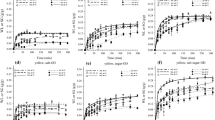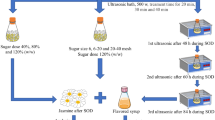Abstract
The uptake of sorbitol and sodium chloride in slabs of green bell pepper (10 × 10 × 2 mm) osmotically dehydrated at different concentrations of sodium chloride (30, 40, and 110 g/L) and sorbitol (7°Bx, 24°Bx, and 41°Bx) at different pressures (4.05, 44.66, and 85.33 kPa) with infusion times ranging from 6 to 60 min for sorbitol and up to 36 min for NaCl was evaluated. Models that describe the uptake of these solutes were developed under different experimental conditions. A completely randomized 3 × 3 factorial design was used to study the effect of the process variables on uptake of solutes for both sorbitol and NaCl. The uptake kinetic of solutes for both sorbitol and NaCl increased to an asymptotic level with both solution concentration and pressure. A negative exponential model adequately fitted the kinetics for both solutes with R 2 = 0.97 and 0.94. The best conditions for the highest increase in total soluble solids during sorbitol solution infusion were 4.05 kPa of pressure and 16 min of immersion. NaCl uptake in peppers followed an exponential trend without reaching the equilibrium conditions. The fitted models were found adequate to estimate that the increase in total soluble solids and NaCl in bell peppers during osmotic process can be used to establish pretreatment conditions in the drying process.



Similar content being viewed by others
References
AOAC (Association of Official Analytical Chemists), (1984). Official methods of analysis (14th ed.). Arlington: AOAC.
Azuara, E., Flores, E., & Beristain, C. I. (2009). Water diffusion and concentration profiles during osmodehydration and storage of apple tissue. Food and Bioprocess Technology, 2, 361–367.
Biswal, R. N., & Bozorgmehr, K. (1992). Mass transfer in mixed solute osmotic dehydration of apple rings. American Society of Agricultural Engineers, 35(1), 257–262.
Chiralt, A., Fito, P., Barat, J. M., Andrés, A., González, C., Escriche, I., et al. (2001). Use of vacuum impregnation in food salting process. Journal of Food Engineering, 49(2–3), 141–151.
Crank, J. (1975). The mathematics of diffusion. London: Oxford University Press.
Dixon, G. M., Jen, J. J., & Paynter, V. A. (1976). Tarty apple slices result from combined osmotic-dehydration and vacuum–drying process. Food Product Development, 10, 634–637.
Eren, I., & Kaymak-Ertekin, F. (2007). Optimization of osmotic dehydration of potato using response surface methodology. Journal of Food Engineering, 79, 344–352.
Fasina, O., Fleming, H., & Thompson, R. (2002). Mass transfer and solute diffusion in brine cucumbers. Journal of Food Science, 67(1), 181–187.
Ferrando, M., & Spiess, W. (2003). Effect of osmotic stress on microstructure and mass transfer in onion and strawberry tissue. Journal of the Science of Food and Agriculture, 83, 951–959.
Fito, P. (1994). Modelling of vacuum osmotic dehydration of food. Journal of Food Engineering, 22, 313–328.
Fito, P., Andrés, A., Chiralt, A., & Pardo, P. (1996). Coupling of hydrodynamic mechanism and deformation-relaxation phenomena during vacuum treatments in solid porous food-liquid systems. Journal of Food Engineering, 21, 229–240.
Hawkes, J., & Flink, J. M. (1978). Osmotic concentration of fruit slices prior to freeze dehydration. Journal of Food Process and Preservation, 2(4), 265–284.
Islam, M. N., & Flink, J. M. (1982). Dehydration of potato II. Osmotic concentration and its effect on air drying behaviour. Journal of Food Technology, 17(3), 387–403.
Ispir, A., & Toğrul, I. T. (2009). Osmotic dehydration of apricot: kinetics and the effect of process parameters. Chemical Engineering Research and Design, 87, 166–180.
Jokić, A., Gyura, J., Lević, L., & Zavargo, Z. (2007). Osmotic dehydration of sugar beet in combined aqueous solutions of sucrose and sodium chloride. Journal of Food Engineering, 78, 47–51.
Kaymak-Ertekin, F., & Sultanoğlu, M. (2000). Modelling of mass transfer during osmotic dehydration of apples. Journal of Food Engineering, 46, 243–250.
Lenart, A., & Flink, J. M. (1984). Osmotic dehydration of potatoes. I. Criteria for the end-point of the osmosis process. Journal of Food Technology, 19(1), 45–63.
Lerici, C. R., Pinnavaia, G., Mastrocola, D. R., & Bartolucci, L. (1985). Influence of osmotic agents on drying behaviour and product quality. Journal of Food Science, 50, 1217–1219.
Moreira, A. P., & Xidieh, M. F. (2004). Mass transfer kinetics of osmotic dehydration of cherry tomato. Journal of Food Engineering, 61(3), 291–295.
Ørskov, E. R., & McDonald, I. (1979). The estimation of protein degradability in the rumen from incubation measurements weighted according to rate of passage. Journal of Agricultural Science (Cambridge)., 92, 499–503.
Ozdemir, M., Ozen, B. F., Dock, L. L., & Floros, J. D. (2008). Optimization of osmotic dehydration of diced green pepper by response surface methodology. Lebensmittel-Wissenschaft und –Technologie, 41(10), 2044–2050.
Ozen, B. F., Dock, L. L., Ozdemir, M., & Floros, J. D. (2002). Processing factors affecting the osmotic dehydration of diced green peppers. International Journal of Food Science and Technology, 37(5), 497–502.
Palou, G. E., López, A., Argaiz, A., & Welti, J. (1994). The use of peleg`s equation to model osmotic concentration of papaya. Drying Technology, 12, 965–978.
Park, K. J., Bin, A., Brod, F. P. R., & Park, T. H. K. B. (2002). Osmotic dehydration kinetics of pear D’anjou (Pyrus communis L.). Journal of Food Engineering, 52(3), 293–298.
Pointing, J. D. (1973). Osmotic dehydration of fruits-recent modifications and applications. Process Biochemistry, 8, 18–20.
Pointing, J. D., Watters, G. G., Forrey, R. R., Jackson, R., & Stanley, W. L. (1966). Osmotic dehydration of fruits. Food Technology, 20, 125–128.
Rastogi, N. K., & Raghavarao, K. S. M. S. (1994). Effect of temperature and concentration of osmotic dehydration coconut. Lebensmittel-Wissenschaft und-.Technologie, 27(6), 264–567.
Rastogi, N. K., & Raghavarao, K. S. M. S. (1996). Kinetics of osmotic dehydration under vacuum. Lebensmittel-Wissenschaft und-.Technologie, 29(7), 669–672.
Rastogi, N. K., & Raghavarao, K. S. M. S. (2004a). Mass transfer during osmotic dehydration: Determination of moisture and solute diffusion coefficients from concentration profiles. Food and Bioproducts Processing, 82(C1), 44–48.
Rastogi, N. K., & Raghavarao, K. S. M. S. (2004b). Mass transfer during osmotic dehydration of pineapple: considering ficksian diffusion in cubical configuration. Lebensmittel-Wissenschaft und-.Technologie, 37(1), 43–47.
Rastogi, N. K., Raghavarao, K. S. M. S., & Niranjan, K. (1997). Mass transfer during osmotic dehydration of banana: Fickian diffusion in cylindrical configuration. Journal of Food Engineering, 31, 423–432.
Ruiz-López, I. I., Castillo-Zamudio, R. I., Salgado-Cervantes, M. A., Rodríguez-Jimenes, G. C., & García-Alvarado, M. A. (2008). Mass transfer modeling during osmotic dehydration of hexahedral pineapple slices in limited volume solutions. Food and Bioprocess Technology, doi:10.1007/s11947-008-0102-x.
Sacchetti, G., Gianotti, A., & Dalla, R. M. (2001). Sucrose-salt combined effects on mass transfer kinetics and product acceptability study on apple osmotic treatments. Journal of Food Engineering, 49, 163–173.
SAS (2001). Statistical Analysis System (Version 8.02). Cary: SAS.
Shi, J., & Le Maguer, M. (2002). Osmotic dehydration of foods: mass transfer and modeling aspects. Food Review International, 18(4), 305–335.
Shi, X.-Q., Fito, P., & Chiralt, A. (1995). Influence of vacuum treatment on mass transfer during osmotic dehydration of fruits. Food Research International, 28(5), 445–454.
Shi, J., Pan, Z., McHugh, T. H., & Hirschberg, E. (2009). Effect of infusion method and parameters on solid gain in blueberries. Food and Bioprocess Technology, 2, 271–278.
Torreggiani, D. (1993). Osmotic dehydration in fruit and vegetable processing. Food Research International, 26, 59–68.
Torreggiani, D., Forni, E., Erba, M. L., & Longoni, F. (1995). Functional properties of pepper osmodehydrated in hydrolyzed cheese whey permeate with or without sorbitol. Food Research International, 28(2), 161–166.
Uddin, M. B., Ainsworth, P., & Ibanoğlu, S. (2004). Evaluation of mass exchange during osmotic dehydration of carrots using response surface methodology. Journal of Food Engineering, 65, 473–477.
Acknowledgements
The authors give special thanks to CONACYT for their financial support to develop this research. The paper is based on author Ricardo Quintero’s thesis for the MS degree.
Author information
Authors and Affiliations
Corresponding author
Rights and permissions
About this article
Cite this article
Quintero-Chávez, R., Quintero-Ramos, A., Jiménez-Castro, J. et al. Modeling of Total Soluble Solid and NaCl Uptake during Osmotic Treatment of Bell Peppers under Different Infusion Pressures. Food Bioprocess Technol 5, 184–192 (2012). https://doi.org/10.1007/s11947-010-0358-9
Received:
Accepted:
Published:
Issue Date:
DOI: https://doi.org/10.1007/s11947-010-0358-9




